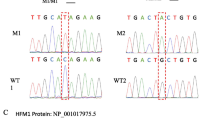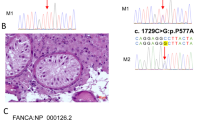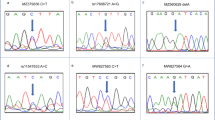Abstract
Etiology of male infertility is intriguing owing to complex genetic regulation of human spermatogenesis and ethnic variations in genetic architecture of human populations. The present study characterizes the role of Y chromosome specific spermatogenic regulator testis-specific protein Y-encoded 1 (TSPY1) gene mutation in spermatogenic failure. This case-control study includes 163 cases of spermatogenic failure and 175 age-matched fertile men as controls. We found five novel base substitutions, namely, MT162695, MN879413, MN889982, MN889983, MN719943, two deletions MN734578 and MN734579, three novel insertions MN719941, MN719942 and MN719944 through Sanger’s dideoxy sequencing of TSPY1 gene reading frame. All these mutations exhibited strong association with male infertility. In silico analyses suggest prospective disruption in splice sites and alteration in different isoforms of TSPY1 transcripts and amino acid sequence in TSPY1 protein. The study provides novel evidence in favour of implication of TSPY1 gene in male fertility. The outcome sheds light to get insight into the issue of idiopathic male infertility in Bengali population.




Similar content being viewed by others

Data Availability
The datasets generated and analyzed during the current study are included in this article.
Code Availability
The original version of software programs is used for statistical modelling. Additionally, some free version software were used to conduct association studies.
References
Grigorova M, Punab M, Kahre T, Ivandi M, Tõnisson N, Poolamets O, et al. The number of CAG and GGN triplet repeats in the Androgen Receptor gene exert combinatorial effect on hormonal and sperm parameters in young men. Andrology. 2017;5:495–504. https://doi.org/10.1111/andr.12344.
Casella R, Maduro MR, Lipshultz LI, Lamb DJ. Significance of the polyglutamine tract polymorphism in the androgen receptor. Urology. 2001;58:651–6. https://doi.org/10.1016/s0090-4295(01)01401-7.
Andersen ML, Guindalini C, Santos-Silva R, Bittencourt LRA, Tufik S. Androgen receptor CAG repeat polymorphism is not associated with erectile dysfunction complaints, gonadal steroids, and sleep parameters: data from a population-based survey. J Androl. 2011;32:524–9. https://doi.org/10.2164/jandrol.110.012013.
Pastuszak AW, Lamb DJ. The genetics of male fertility--from basic science to clinical evaluation. J Androl. 2012;33:1075–84. https://doi.org/10.2164/jandrol.112.017103.
Tirumala Vani G, Mukesh N, Siva Prasad B, Rama Devi P, Hema Prasad M, Usha Rani P, et al. Role of glutathione S-transferase Mu-1 (GSTM1) polymorphism in oligospermic infertile males. Andrologia. 2010;42:213–7. https://doi.org/10.1111/j.1439-0272.2009.00971.x.
Olshan AF, Luben TJ, Hanley NM, Perreault SD, Chan RL, Herring AH, et al. Preliminary examination of polymorphisms of GSTM1, GSTT1, and GSTZ1 in relation to semen quality. Mutat Res. 2010;688:41–6. https://doi.org/10.1016/j.mrfmmm.2010.03.002.
Safarinejad MR, Shafiei N, Safarinejad S. The association of glutathione-S-transferase gene polymorphisms (GSTM1, GSTT1, GSTP1) with idiopathic male infertility. J Hum Genet. 2010;55:565–70. https://doi.org/10.1038/jhg.2010.59.
Liu S-Y, Zhang C-J, Peng H-Y, Sun H, Lin K-Q, Huang X-Q, et al. Strong association of SLC1A1 and DPF3 gene variants with idiopathic male infertility in Han Chinese. Asian J Androl. 2017;19:486–92. https://doi.org/10.4103/1008-682X.178850.
Vodicka R, Vrtel R, Dusek L, Singh AR, Krizova K, Svacinova V, et al. TSPY gene copy number as a potential new risk factor for male infertility. Reprod BioMed Online. 2007;14:579–87. https://doi.org/10.1016/s1472-6483(10)61049-8.
Giachini C, Nuti F, Turner DJ, Laface I, Xue Y, Daguin F, et al. TSPY1 copy number variation influences spermatogenesis and shows differences among Y lineages. J Clin Endocrinol Metab. 2009;94:4016–22. https://doi.org/10.1210/jc.2009-1029.
Zhang JS, Yang-Feng TL, Muller U, Mohandas TK, de Jong PJ, Lau YF. Molecular isolation and characterization of an expressed gene from the human Y chromosome. Hum Mol Genet. 1992;1:717–26. https://doi.org/10.1093/hmg/1.9.717.
Arnemann J, Epplen JT, Cooke HJ, Sauermann U, Engel W, Schmidtke J. A human Y-chromosomal DNA sequence expressed in testicular tissue. Nucleic Acids Res. 1987;15:8713–24. https://doi.org/10.1093/nar/15.21.8713.
Oram SW, Liu XX, Lee T-L, Chan W-Y, Lau Y-FC. TSPY potentiates cell proliferation and tumorigenesis by promoting cell cycle progression in HeLa and NIH3T3 cells. BMC Cancer. 2006;6:154. https://doi.org/10.1186/1471-2407-6-154.
Yin YH, Li YY, Qiao H, Wang HC, Yang XA, Zhang HG, et al. TSPY is a cancer testis antigen expressed in human hepatocellular carcinoma. Br J Cancer. 2005;93:458–63. https://doi.org/10.1038/sj.bjc.6602716.
Kersemaekers A-MF, Honecker F, Stoop H, Cools M, Molier M, Wolffenbuttel K, et al. Identification of germ cells at risk for neoplastic transformation in gonadoblastoma: an immunohistochemical study for OCT3/4 and TSPY. Hum Pathol. 2005;36:512–21. https://doi.org/10.1016/j.humpath.2005.02.016.
Nickkholgh B, Noordam MJ, Hovingh SE, van Pelt AMM, van der Veen F, Repping S. Y chromosome TSPY copy numbers and semen quality. Fertil Steril. 2010;94:1744–7. https://doi.org/10.1016/j.fertnstert.2009.09.051.
WHO laboratory manual for the examination and processing of human semen. 5th edn. World Health Organization; 2010.
Gasteiger E, Gattiker A, Hoogland C, Ivanyi I, Appel RD, Bairoch A. ExPASy: the proteomics server for in-depth protein knowledge and analysis. Nucleic Acids Res. 2003;31:3784–8. https://doi.org/10.1093/nar/gkg563.
Adzhubei IA, Schmidt S, Peshkin L, Ramensky VE, Gerasimova A, Bork P, et al. A method and server for predicting damaging missense mutations. Nat Methods. 2010;7:248–9. https://doi.org/10.1038/nmeth0410-248.
Schwarz JM, Hombach D, Köhler S, Cooper DN, Schuelke M, Seelow D. RegulationSpotter: annotation and interpretation of extratranscriptic DNA variants. Nucleic Acids Res. 2019;47:W106–13. https://doi.org/10.1093/nar/gkz327.
Lubeck E, Coskun AF, Zhiyentayev T, Ahmad M, Cai L. Single-cell in situ RNA profiling by sequential hybridization. Nat Methods. 2014;11:360–1. https://doi.org/10.1038/nmeth.2892.
Choi Y, Sims GE, Murphy S, Miller JR, Chan AP. Predicting the functional effect of amino acid substitutions and indels. PLoS One. 2012;7:e46688. https://doi.org/10.1371/journal.pone.0046688.
Li W, Godzik A. Cd-hit: a fast program for clustering and comparing large sets of protein or nucleotide sequences. Bioinformatics. 2006;22:1658–9. https://doi.org/10.1093/bioinformatics/btl158.
Sim N-L, Kumar P, Hu J, Henikoff S, Schneider G, Ng PC. SIFT web server: predicting effects of amino acid substitutions on proteins. Nucleic Acids Res. 2012;40:W452–7. https://doi.org/10.1093/nar/gks539.
Vaser R, Adusumalli S, Leng SN, Sikic M, Ng PC. SIFT missense predictions for genomes. Nat Protoc. 2016;11:1–9. https://doi.org/10.1038/nprot.2015.123.
Kumar P, Henikoff S, Ng PC. Predicting the effects of coding non-synonymous variants on protein function using the SIFT algorithm. Nat Protoc. 2009;4:1073–81. https://doi.org/10.1038/nprot.2009.86.
Ng PC, Henikoff S. SIFT: predicting amino acid changes that affect protein function. Nucleic Acids Res. 2003;31:3812–4. https://doi.org/10.1093/nar/gkg509.
Desmet F-O, Hamroun D, Lalande M, Collod-Béroud G, Claustres M, Béroud C. Human Splicing Finder: an online bioinformatics tool to predict splicing signals. Nucleic Acids Res. 2009;37:e67. https://doi.org/10.1093/nar/gkp215.
Piva F, Giulietti M, Nocchi L, Principato G. SpliceAid: a database of experimental RNA target motifs bound by splicing proteins in humans. Bioinformatics. 2009;25:1211–3. https://doi.org/10.1093/bioinformatics/btp124.
Krausz C, Giachini C, Forti G, et al. TSPY and male fertility. Genes (Basel). 2010;1:308–16. https://doi.org/10.3390/genes1020308.
Repping S, van Daalen SK, Brown LG, Korver CM, Lange J, Marszalek JD, Pyntikova T, van der Veen F, Skaletsky H, Page DC, Rozen S, et al. High mutation rates have driven extensive structural polymorphism among human Y chromosomes. Nat Genet. 2006;38:463–7. https://doi.org/10.1038/ng1754.
Mathias N, Bayes M, Tyler-Smith C, et al. Highly informative compound haplotypes for the human Y chromosome. Hum Mol Genet. 1994;3:115–23. https://doi.org/10.1093/hmg/3.1.115.
Luján S, Caroppo E, Niederberger C, Arce J-C, Sadler-Riggleman I, Beck D, et al. Sperm DNA methylation epimutation biomarkers for male infertility and FSH therapeutic responsiveness. Sci Rep. 2019;9:16786. https://doi.org/10.1038/s41598-019-52903-1.
Schnieders F, Dörk T, Arnemann J, Vogel T, Werner M, Schmidtke J, et al. Testis-specific protein, Y-encoded (TSPY) expressionin testicular tissues. Hum Mol Genet. 1996;5:1801–7. https://doi.org/10.1093/hmg/5.11.1801.
Shen Y, Yan Y, Liu Y, Zhang S, Yang D, Zhang P, et al. A significant effect of the TSPY1 copy number on spermatogenesis efficiency and the phenotypic expression of the gr/gr deletion. Hum Mol Genet. 2013;22:1679–95. https://doi.org/10.1093/hmg/ddt004.
Svacinova V, Vodicka R, Vrtel R, Godava M, Kvapilova M, Krejcirikova E, et al. Sequence recombination in exon 1 of the TSPY gene in men with impaired fertility. Biomed Pap Med Fac Univ Palacky Olomouc Czech Repub. 2011;155:287–98. https://doi.org/10.5507/bp.2011.034.
Acknowledgements
We are thankful to all the participating volunteers who gave their consents to use tissue samples. We are thankful to all the clinician medical staffs for their active cooperation in sample collection. The departmental instrumental facilities were supported by UGC-UPE II, DST-FIST, DST-PURSE program at the University of Calcutta. Pranab Paladhi is thankful to ICMR India, for providing him fellowship.
Funding
The study was supported financially by the grants from Indian Council for Medical Research, Grant Number: 5/10/FR/10/2015-RCH.
Author information
Authors and Affiliations
Contributions
SG conceptualized the project, designed the experiments and wrote the paper. PP performed the major experiments, analyzed data, reported the novel variants and wrote the paper. PG, SD and SP helped in experiments and data analysis. BC, RC, IS and GB recruited infertile as well as control individuals, confirmed diagnosis of the infertile patients and recorded epidemiological data. All authors approved the last version.
Corresponding author
Ethics declarations
Ethics Approval
The study was conducted following the declaration of Helsinki and rules outlined by the Indian Council of Medical Research. Ethical approval was obtained by the ethics review board constituted by the University of Calcutta.
Consent to Participate
All the families consented to participate in the study.
Consent for Publication
All the families consented for publication of data based on their donated tissue and information.
Conflict of Interest
The authors declare no competing interests.
Web Resources
http://biomodel.uah.es/en/lab/cybertory/analysis/trans.htm
https://blast.ncbi.nlm.nih.gov/Blast.cgi?PAGE=Nucleotides
https://www.ncbi.nlm.nih.gov/orffinder/
https://web.expasy.org/translate/
http://genetics.bwh.harvard.edu/pph2/
https://www.regulationspotter.org/
http://provean.jcvi.org/index.php
https://sift.bii.a-star.edu.sg/
http://www.introni.it/splicing.html
https://gnomad.broadinstitute.org/variant/Y-9306347-G-A?dataset=gnomad_r2_1
Additional information
Publisher’s Note
Springer Nature remains neutral with regard to jurisdictional claims in published maps and institutional affiliations.
Supplementary Information
Below is the link to the electronic supplementary material.
43032_2021_839_MOESM1_ESM.pdf
Supplementary Information 1 Outcome of in silico analyses by Polyphen-2 program shows the effect of mutations MT162695 (NC_000024.10:g.9467148G>C), MN879413 (NC_000024.10:g.9467392C>T), MN889982 (NC_000024.10:g.9467443G>T) and MN719943 (NC_000024.10:g.9468104A>C) on TSPY1 transcript and protein (PDF 536 kb)
43032_2021_839_MOESM2_ESM.pdf
Supplementary Information 2 Outcome of in silico analyses by RegulationSpotter-program shows the effect of mutations MT162695 (NC_000024.10:g.9467148G>C), MN879413 (NC_000024.10:g.9467392C>T), MN889982 (NC_000024.10:g.9467443G>T), MN889983 (NC_000024.10:g.9467643G>A), MN719943 (NC_000024.10:g.9468104A>C) and rs566754601 (NC_000024.10:g.9468738G>A) on TSPY1 transcript and protein. (PDF 396 kb)
43032_2021_839_MOESM3_ESM.pdf
Supplementary Information 3 Outcome of in silico analyses by PROVEAN program shows the effect of mutations MT162695 (NC_000024.10:g.9467148G>C), MN879413 (NC_000024.10:g.9467392C>T), MN889982 (NC_000024.10:g.9467443G>T) and MN719943 (NC_000024.10:g.9468104A>C) on TSPY1 transcript and protein. (PDF 395 kb)
43032_2021_839_MOESM4_ESM.pdf
Supplementary Information 4 Outcome of in silico analyses by SIFT program shows the effect of mutations MT162695 (NC_000024.10:g.9467148G>C), MN879413 (NC_000024.10:g.9467392C>T), MN889982 (NC_000024.10:g.9467443G>T), MN719943 (NC_000024.10:g.9468104A>C), MN719944 (NC_000024.10:g.9468815_9468816insA) and MN734578 (NC_000024.10:g.9468830del) on TSPY1 transcript and protein. (PDF 575 kb)
43032_2021_839_MOESM5_ESM.pdf
Supplementary Information 5 Outcome of in silico analyses by Human-Splicing Finder program shows the effect of mutations MT162695(NC_000024.10:g.9467148G>C), MN879413(NC_000024.10:g.9467392C>T), MN889982(NC_000024.10:g.9467443G>T), MN889983(NC_000024.10:g.9467643G>A), MN719943(NC_000024.10:g.9468104A>C), MN734579(NC_000024.10:g.9468207del), MN719941(NC_000024.10:g.9468698_9468699insT), MN719942(NC_000024.10:g.9468711_9468712insG), rs566754601 (NC_000024.10:g.9468738G>A), MN719944(NC_000024.10:g.9468815_9468816insA) and MN734578(NC_000024.10:g.9468830del) on TSPY1 transcript and protein. (PDF 3316 kb)
Rights and permissions
About this article
Cite this article
Paladhi, P., Dutta, S., Pal, S. et al. Novel Mutations of TSPY1 Gene Associate Spermatogenic Failure Among Men. Reprod. Sci. 29, 1241–1261 (2022). https://doi.org/10.1007/s43032-021-00839-1
Received:
Accepted:
Published:
Issue Date:
DOI: https://doi.org/10.1007/s43032-021-00839-1



